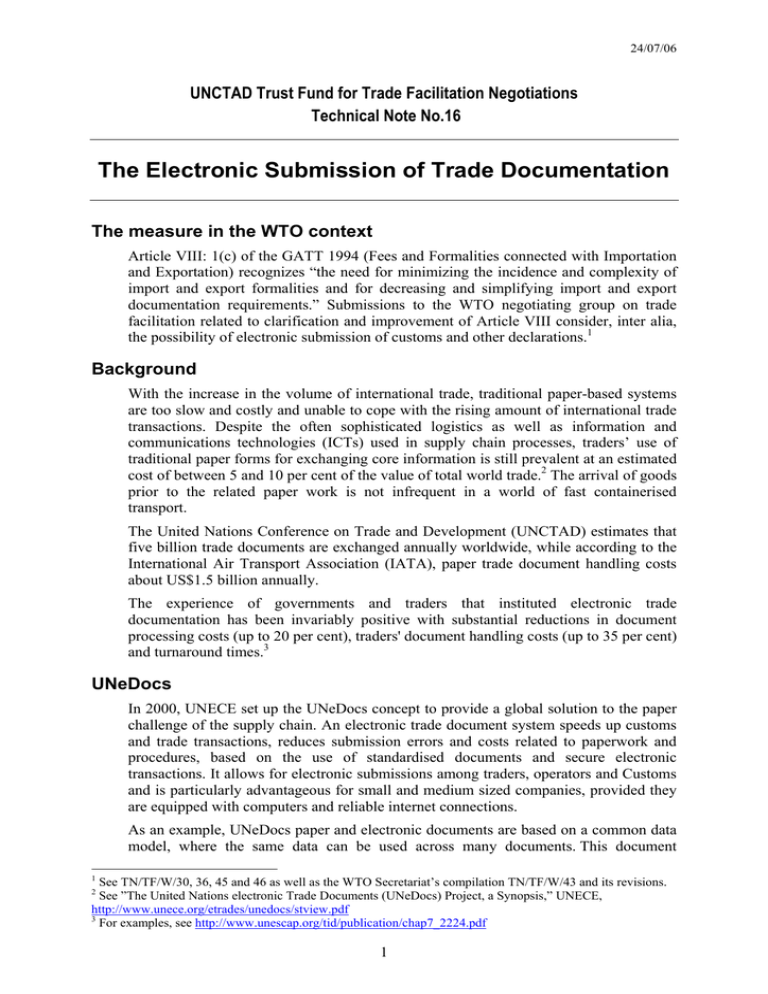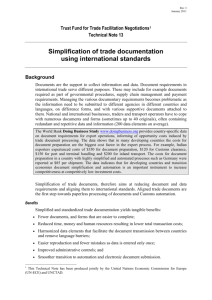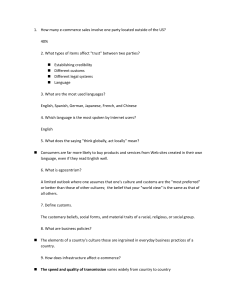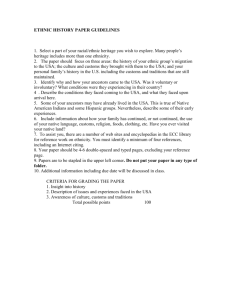The Electronic Submission of Trade Documentation
advertisement

24/07/06 UNCTAD Trust Fund for Trade Facilitation Negotiations Technical Note No.16 The Electronic Submission of Trade Documentation The measure in the WTO context Article VIII: 1(c) of the GATT 1994 (Fees and Formalities connected with Importation and Exportation) recognizes “the need for minimizing the incidence and complexity of import and export formalities and for decreasing and simplifying import and export documentation requirements.” Submissions to the WTO negotiating group on trade facilitation related to clarification and improvement of Article VIII consider, inter alia, the possibility of electronic submission of customs and other declarations.1 Background With the increase in the volume of international trade, traditional paper-based systems are too slow and costly and unable to cope with the rising amount of international trade transactions. Despite the often sophisticated logistics as well as information and communications technologies (ICTs) used in supply chain processes, traders’ use of traditional paper forms for exchanging core information is still prevalent at an estimated cost of between 5 and 10 per cent of the value of total world trade.2 The arrival of goods prior to the related paper work is not infrequent in a world of fast containerised transport. The United Nations Conference on Trade and Development (UNCTAD) estimates that five billion trade documents are exchanged annually worldwide, while according to the International Air Transport Association (IATA), paper trade document handling costs about US$1.5 billion annually. The experience of governments and traders that instituted electronic trade documentation has been invariably positive with substantial reductions in document processing costs (up to 20 per cent), traders' document handling costs (up to 35 per cent) and turnaround times.3 UNeDocs In 2000, UNECE set up the UNeDocs concept to provide a global solution to the paper challenge of the supply chain. An electronic trade document system speeds up customs and trade transactions, reduces submission errors and costs related to paperwork and procedures, based on the use of standardised documents and secure electronic transactions. It allows for electronic submissions among traders, operators and Customs and is particularly advantageous for small and medium sized companies, provided they are equipped with computers and reliable internet connections. As an example, UNeDocs paper and electronic documents are based on a common data model, where the same data can be used across many documents. This document 1 See TN/TF/W/30, 36, 45 and 46 as well as the WTO Secretariat’s compilation TN/TF/W/43 and its revisions. See ”The United Nations electronic Trade Documents (UNeDocs) Project, a Synopsis,” UNECE, http://www.unece.org/etrades/unedocs/stview.pdf 3 For examples, see http://www.unescap.org/tid/publication/chap7_2224.pdf 2 1 24/07/06 concept retains the flexibility for traders to choose the type of document technology that best meets their business requirements and technology capabilities. Established formats, such as UNeDocs, standardise, for example, country, port, currency, measurement units and other codes for e-documents, which enable computer processing and payments through banks. These e-documents would also comply with national regulatory, legal, taxation and other requirements. UNeDocs documents can be translated and adapted to national requirements to build national sets of aligned trade documents. By harmonising their formats and codes upon adopting UNeDocs, the United States and Australia reduced the number of data elements in their documents by 90 per cent.4 If coupled with Customs automation (see Technical Note 3), such systems can also capture advance information required for risk management techniques (see Technical Note 12) and pre-arrival customs clearance (see Technical Note 15). Moreover, they can make trade procedures more transparent and predictable (see Technical Note 7). Benefits and costs At the initial stages of introducing the electronic submission of documents, the overall costs of the system may temporarily increase because parallel systems – paper and electronic – need to be maintained until the legal and administrative adoption of electronic data systems. Among the benefits of electronic systems for the submission of trade documentation are: • faster document processing and release of goods • enhanced revenue collection and faster payments • more accurate and faster compilation of trade statistics • improved regulatory and procedural transparency and predictability • reduced transactions costs Moving to electronic documents will require investments, especially by SMEs, in computer facilities and internet connectivity, and software. Adequately trained customs experts who can adapt regulatory and procedural requirements and documentation standards to national requirements are also needed. Implementation time and costs are a function of each country’s starting point, human resource capacity and infrastructure. Many countries today have introduced automation of trade procedures (such as ASYCUDA) or some use of electronic documentation. The maintenance and, above all, the updating of these systems require trained staff to safeguard smooth and efficient operations. An important component of the costs is due to capacity building measures and staff training in those agencies that have to operate the automated system. There is now ample evidence that not only are costs recovered relatively quickly but also revenues increase substantially owing to more efficient formalities and documentation processing, which tend to increase trade traffic. 4 See ”Workshop on International Standards to Stimulate Paperless Trade,” 20-21 February 2006 http://www.unece.org/trade/workshop/malaysia_feb06/presentations/269,8, UNLK Form Families 2 24/07/06 Implementation issues Phased implementation The process of introducing the electronic submission of trade documents, including customs declarations, licences and certificates, has to be planned carefully and based on a phased approach (see Box 1). The transition of moving from paper trade documents to simplified and standardized paper trade documents and then to electronic documents should be gradual. A transition period has to be set at the outset of the process. Box 1: Tunisia Trade Net The development process of electronic trade document system in Tunisia, the Tunisia Trade Net, was made in tree main stages: - 1997: Preparatory stage - setting up Trade Procedures Facilitation Committee and launching discussions and pilot projects - 2000: Simplification and standardization trade documents (based on the United Nations Layout Key and UN Trade Data Element Directory) and trade procedures; - 2002: Transition from paper to electronic trade documents and creation of an electronic Single Window system. The introduction of electronic trade documents submission might initially be limited to selected documents, or cover only exports of certain goods categories. During the initial period, the system could accept only the simpler type of documents such as those for non-dutiable and non-controlled goods for processing. After the system has been tested and stabilized and after consulting relevant stakeholders, the lead agency may consider extending the system to include documents for other goods, including controlled or quota items. This process could further evolve by connecting all border agencies and other relevant administrations through an electronic Single Window facility - a one-stop-shop for submitting and processing all electronic trade documents. It can also include electronic payment of duties and other fees and charges (see Box 2). Box 2: Single Window e-Logistics Environment project in Thailand Thailand has initiated the Thailand Single Window e-Logistics Environment, to be accomplished in 2009. The pilot project, launched in 2005, includes an implementation of a Single Window e-Licensing and e-Certificates systems for exporting fruits and automobiles. The project will be gradually extended to more products, and later all imports, exports and transport activities. In the final cycle it will cover cross-border electronic documents exchange within the ASEAN Single Window Initiative. As a general observation, the introduction of electronic documentation systems until now has largely involved replacement of individual paper forms with electronic versions. In the context of a comprehensive Customs reform, including automation, the simplification and standardisation of documents and procedures may call for a redesign of documentation and data forms rather than producing electronic copies of old forms. A lead agency and financial support To assure financial and operational sustainability, a strong lead agency (e.g. Customs) and an unwavering political commitment are indispensable. This lead agency would be responsible for drawing up the concept of the project, setting the policy direction for change and setting up the mechanism to implement the new electronic trade documents system. Investment in appropriate infrastructure and information and communication 3 24/07/06 technologies (ICT) needs to be secured. This could be shared between the government and private sector stakeholders. Partnership between government and business A partnership between government and business holds the key to success. The lead agency needs to build up trust and cooperation with all stakeholders, including within the public sector (such as Ministries of Trade, Transport, Finance/ Treasury, Agriculture, veterinary and phytosanitary agencies), within the private sector (importers, exporters, freight forwarders, carriers, customs brokers, terminal operators, banks, insurance agents), as well as between the public and the private sector. Legal issues and creating awareness Import and export procedures are codified in national laws and regulations. In addition, a regulatory framework is required to enable electronic processing and electronic signature verification and authentication. The lead agency should be responsible for advertising these changes well in advance to allow traders to become acquainted with the new regulations on import/ export procedures. A reasonable time period should be granted for integrating them into their own business processes. The benefits of such trade facilitation measures should be highlighted and incentives provided in the form of lower fees for electronic documents submission, reduced clearance times and release-times etc. to promote the use of electronic versions of customs declarations and other trade documents. Simplification and standardisation Prior to the introduction of electronic documentation, import/ export procedures should be streamlined and simplified, as complicated procedures contravene the gains in efficiency arising from the use of ICT. The next step is to simplify and standardise paper trade documents by reducing the number of forms and documents to a minimum and aligning their formats and data requirements to international standards. Several developed and developing countries started from a simpler export documents set (including for example Customs Export Declaration, Invoice, Shipping Instructions), which was aligned with the United Nations Layout Key (UNLK). Using UNLK ensures that the same information and data are found in the same place on all documents, based on one master document, and the same format is used regardless the size of paper. Such a document can then be reproduced by printers, software products for computer systems or web services providers. As trade documents are usually structured in a “box format” with data displayed in boxes, it is important to match them with standard data elements. United Nations Trade Data Elements Directory (UNTDED) and UN/EDIFACT standards are being widely used for this purpose. Such matching would not only align data with international standards (see Technical Note 13) but also facilitate the transition to electronic trade documents such as UNeDocs. References and tools available United Nations Layout Key for Trade Documents (UNLK; ISO 6422) The UNLK is an international standard for trade documents integrating a set of international standards and codes for the design of aligned series of forms using a 4 24/07/06 master document. It can also be used to design screen layouts for the visual display of electronic documents. www.unece.org/cefact/recommendations/rec_index.htm. The United Nations Trade Data Elements Directory (UNTDED; ISO 7372) UNTDED contains the standard data elements that can be used with any method for data interchange on paper documents as well as with other means of data communication. www.unece.org/cefact. UN/EDIFACT United Nations Electronic Data Interchange for Administration, Commerce and Transport (UN/EDIFACT) is a set of internationally agreed standards, directories and guidelines for the electronic interchange of structured data, and in particular that related to trade in goods and services between independent, computerised information systems. www.unece.org/trade/untdid/welcome.htm. WCO Customs Data Model The WCO Customs Data Model provides a framework of standardized and harmonized sets of data and standard electronic messages to be submitted by trade for customs and other regulatory purposes to accomplish formalities for the arrival, departure, transit and clearance of goods in international cross-border trade. It enables the various information systems of a customs service, its trading partners as well as cooperating Customs and other regulatory authorities to work together in the most effective way. www.wcoomd.org. WCO Customs Data Model Handbook (2003) UNeDocs United Nations Electronic Trade Documents (UNeDocs) provides a framework for developing aligned paper trade documents based on international trade standards and the subsequent development of the electronic equivalents of the paper document. UNeDocs designs documents on the basis of international trade procedures, UNLK and UNTDED. The first International Document Set, comprising 12 trade documents, is available for traders. www.unece.org/etrades/unedocs. ASYCUDA The Automated System for Customs Data (ASYCUDA) is a computerised customs management system comprising most foreign trade procedures. The system handles manifests and customs declarations, accounting procedures, transit and suspense procedures. ASYCUDA generates trade data that can be used for statistical economic analysis. www.asycuda.org. 5 24/07/06 Single Window UN/CEFACT Recommendation 33 recommends establishing a Single Window facility, allowing parties involved in trade and transport to lodge standardized information and documents at a single entry point to fulfil all import, export, and transit-related regulatory requirements. If information is electronic, then individual data elements should only be submitted once. This may also provide a platform for coordinating controls among the agencies involved and payment of relevant duties, taxes and fees. www.unece.org/cefact/recommendations/rec33/rec33_ecetrd352_e.pdf. UNCITRAL Model Laws on Electronic Commerce and on Electronic Signatures This Model law on electronic commerce provides standards by which the legal value of electronic messages can be assessed and rules for electronic commerce in specific areas, including carriage of goods. This model law establishes criteria of technical reliability for the equivalence between electronic and handwritten signatures. www.uncitral.org http://www.uncitral.org/pdf/english/texts/electcom/ml-elecsig-e.pdf http://daccessdds.un.org/doc/UNDOC/GEN/N05/488/80/PDF/N0548880.pdf?OpenEle ment UNCITRAL Model Law on Electronic Signatures http://www.uncitral.org/uncitral/en/uncitral_texts/electronic_commerce/2001Model_stat us.html. 6






